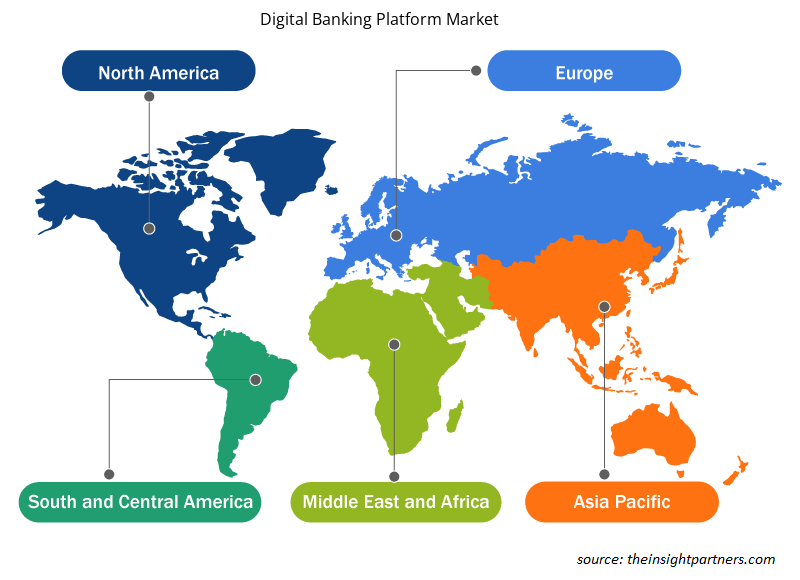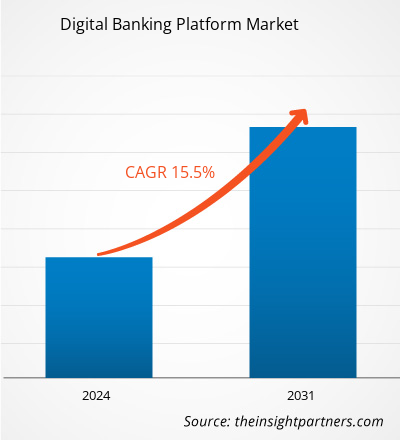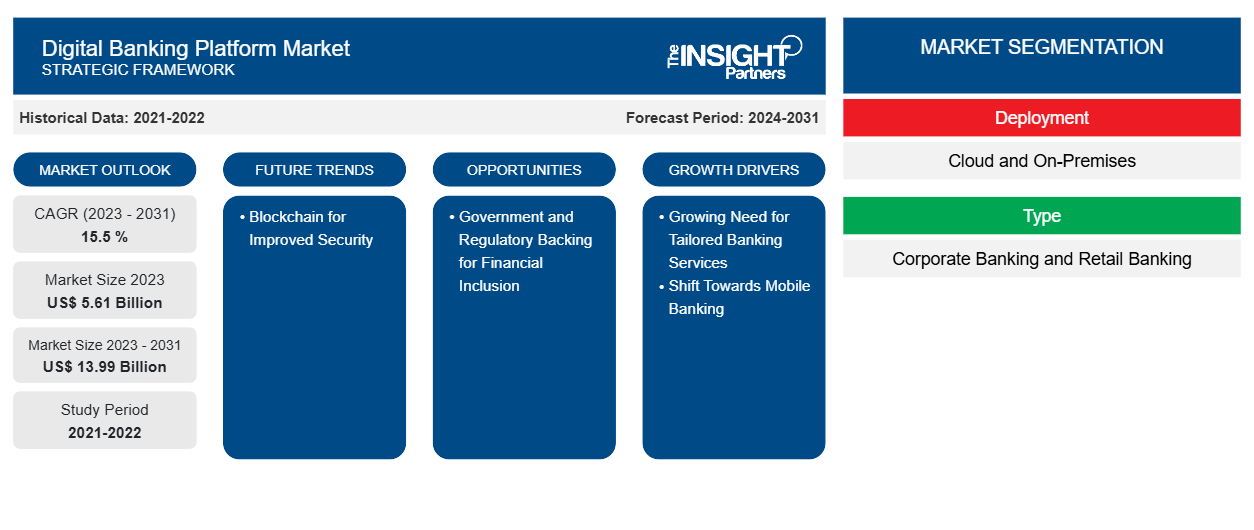Der Markt für digitale Bankplattformen soll von 5,61 Milliarden US-Dollar im Jahr 2023 auf 13,99 Milliarden US-Dollar im Jahr 2031 anwachsen. Der Markt soll zwischen 2023 und 2031 eine durchschnittliche jährliche Wachstumsrate (CAGR) von 15,5 % verzeichnen. Der wachsende Bedarf an maßgeschneiderten Bankdienstleistungen und regulatorischer Unterstützung für die finanzielle Inklusion dürfte weiterhin die wichtigsten Trends auf dem Markt für digitale Bankplattformen bleiben.
Marktanalyse für digitale Banking-Plattformen
Da die Nutzung von Mobiltelefonen zunimmt, entscheiden sich immer mehr Menschen aufgrund der Bequemlichkeit für das Mobile Banking. Dieser Wandel hat die Banken dazu ermutigt, digitale Banksysteme zu entwickeln, die auf mobilen Geräten genutzt werden können, sodass Benutzer ihre Bankgeschäfte auch unterwegs erledigen können. Darüber hinaus helfen diese Systeme den Banken, ihre Abläufe effizienter zu gestalten, Kosten zu senken und moderne Technologien wie KI und Datenanalyse zu integrieren, um Dienstleistungen zu personalisieren und die Entscheidungsfindung zu verbessern.
Marktübersicht für digitale Banking-Plattformen
Eine digitale Bankplattform ist ein elektronisches System, das über das Internet oder mobile Apps verfügbar ist und es Verbrauchern ermöglicht, verschiedene Bankgeschäfte und Finanztransaktionen aus der Ferne durchzuführen. Zu diesen Aufgaben gehören Kontoverwaltung, Zahlungen, Kreditanträge und Zugriff auf eine breite Palette von Bankdienstleistungen. Die Plattform bietet auch Funktionen wie Kontoverwaltung, mobile Einzahlungen, digitale Geldbörsen, Budgetierungstools und Kundensupport über Chatbots oder Messaging-Dienste. Die Hauptvorteile digitaler Bankplattformen sind Komfort, Zugänglichkeit und Effizienz für Kunden und Banken. Benutzer können bequem Bankgeschäfte durchführen , ohne eine physische Filiale besuchen zu müssen, was zu einer höheren Kundenzufriedenheit und -bindung führt.
Passen Sie diesen Bericht Ihren Anforderungen an
Sie erhalten kostenlos individuelle Anpassungen an jedem Bericht, einschließlich Teilen dieses Berichts oder einer Analyse auf Länderebene, eines Excel-Datenpakets sowie tolle Angebote und Rabatte für Start-ups und Universitäten.
-
Holen Sie sich die wichtigsten Markttrends aus diesem Bericht.Dieses KOSTENLOSE Beispiel umfasst eine Datenanalyse von Markttrends bis hin zu Schätzungen und Prognosen.
Markttreiber und Chancen für digitale Banking-Plattformen
Steigender Bedarf an maßgeschneiderten Bankdienstleistungen zur Förderung des Marktes
Es gibt einen zunehmenden Trend, dass Kunden personalisierte Finanzdienstleistungen wünschen, was Banken dazu veranlasst, digitale Plattformen für maßgeschneiderte Erfahrungen einzusetzen. Durch digitales Banking können Banken spezialisierte Finanzprodukte und -dienstleistungen anbieten und so die Loyalität und Kundenzufriedenheit erhöhen. Die steigende Nachfrage nach personalisierten Bankdienstleistungen spiegelt eine Verschiebung der Verbraucherpräferenzen hin zu maßgeschneiderten Finanzlösungen wider. Kunden wünschen sich heute personalisierte Erfahrungen, die ihren spezifischen Bedürfnissen entsprechen, was Banken dazu veranlasst, digitale Plattformen für ein individuelleres Bankerlebnis zu nutzen.
Staatliche und regulatorische Unterstützung für die finanzielle Inklusion
Die weltweiten Bemühungen, das digitale Banking zu fördern, basieren auf der Erkenntnis, dass es ein erhebliches Potenzial zur Verbesserung der finanziellen Inklusion bietet. Durch die Nutzung digitaler Plattformen können nun Personen, die bisher vom formellen Finanzsystem ausgeschlossen waren, wie etwa Personen ohne oder mit unzureichendem Zugang zu Bankdienstleistungen, auf wichtige Finanzdienstleistungen zugreifen. Diese Ausweitung des Finanzzugangs verringert nicht nur die Ungleichheit zwischen Menschen mit und ohne Bankdienstleistungen, sondern fördert auch das Wirtschaftswachstum, indem mehr Menschen die Teilnahme an der formellen Wirtschaft ermöglicht wird. Folglich dient die regulatorische Unterstützung des digitalen Bankings nicht nur als Mittel zur Verbesserung der finanziellen Inklusion, sondern auch als Strategie zur Förderung des allgemeinen wirtschaftlichen Fortschritts und zur Minimierung gesellschaftlicher Ungleichheiten.
Segmentierungsanalyse des Marktberichts für digitale Banking-Plattformen
Wichtige Segmente, die zur Ableitung der Marktanalyse für digitale Banking-Plattformen beigetragen haben, sind Bereitstellung und Typ.
- Basierend auf der Bereitstellung ist der Markt in Cloud und On-Premises unterteilt. Das On-Premises-Segment hielt im Jahr 2023 einen bedeutenden Marktanteil.
- Nach Typ ist der Markt in Firmenkundengeschäft und Privatkundengeschäft segmentiert. Das Segment Firmenkundengeschäft hielt im Jahr 2023 einen erheblichen Marktanteil.
Marktanteilsanalyse für digitale Banking-Plattformen nach geografischer Lage
Der geografische Umfang des Marktberichts zur digitalen Bankplattform ist hauptsächlich in fünf Regionen unterteilt: Nordamerika, Asien-Pazifik, Europa, Naher Osten und Afrika sowie Südamerika/Süd- und Mittelamerika.
Nordamerika, insbesondere die USA, weist eine der weltweit höchsten Technologieakzeptanzraten auf. Die weit verbreitete Nutzung von Smartphones und die starke Internetdurchdringung schaffen ein ideales Umfeld für die Entwicklung und Dominanz digitaler Bankdienstleistungen. Die gut etablierte Finanzinfrastruktur der Region fördert Innovationen im digitalen Bankwesen, unterstützt durch einen ausgereiften Bankensektor, ein günstiges regulatorisches Umfeld und erhebliche Investitionen in Fintech -Unternehmen. Verbraucher in Nordamerika zeigen eine starke Präferenz für digitale Dienstleistungen, einschließlich Bankdienstleistungen, getrieben von dem Wunsch nach schnellen, einfachen und sicheren Online-Banking-Transaktionen. Diese Nachfrage motiviert Banken und Finanzinstitute, ihre digitalen Plattformen kontinuierlich zu verbessern.
Regionale Einblicke in den Markt für digitale Banking-Plattformen
Die regionalen Trends und Faktoren, die den Markt für digitale Bankplattformen im Prognosezeitraum beeinflussen, wurden von den Analysten von Insight Partners ausführlich erläutert. In diesem Abschnitt werden auch die Marktsegmente und die Geografie digitaler Bankplattformen in Nordamerika, Europa, im asiatisch-pazifischen Raum, im Nahen Osten und Afrika sowie in Süd- und Mittelamerika erörtert.

- Erhalten Sie regionale Daten zum Markt für digitale Banking-Plattformen
Umfang des Marktberichts zur digitalen Banking-Plattform
| Berichtsattribut | Details |
|---|---|
| Marktgröße im Jahr 2023 | 5,61 Milliarden US-Dollar |
| Marktgröße bis 2031 | 13,99 Milliarden US-Dollar |
| Globale CAGR (2023 - 2031) | 15,5 % |
| Historische Daten | 2021-2022 |
| Prognosezeitraum | 2024–2031 |
| Abgedeckte Segmente |
Nach Bereitstellung
|
| Abgedeckte Regionen und Länder |
Nordamerika
|
| Marktführer und wichtige Unternehmensprofile |
|
Marktteilnehmerdichte: Der Einfluss auf die Geschäftsdynamik
Der Markt für digitale Banking-Plattformen wächst rasant, angetrieben durch die steigende Nachfrage der Endnutzer aufgrund von Faktoren wie sich entwickelnden Verbraucherpräferenzen, technologischen Fortschritten und einem größeren Bewusstsein für die Vorteile des Produkts. Mit steigender Nachfrage erweitern Unternehmen ihr Angebot, entwickeln Innovationen, um die Bedürfnisse der Verbraucher zu erfüllen, und nutzen neue Trends, was das Marktwachstum weiter ankurbelt.
Die Marktteilnehmerdichte bezieht sich auf die Verteilung der Firmen oder Unternehmen, die in einem bestimmten Markt oder einer bestimmten Branche tätig sind. Sie gibt an, wie viele Wettbewerber (Marktteilnehmer) in einem bestimmten Marktraum im Verhältnis zu seiner Größe oder seinem gesamten Marktwert präsent sind.
Die wichtigsten auf dem Markt für digitale Banking-Plattformen tätigen Unternehmen sind:
- Appway AG
- CREALOGIX Holding AG
- EdgeVerve Systems Limited
- Fiserv, Inc.
- Oracle Corporation
- SAP SE
Haftungsausschluss : Die oben aufgeführten Unternehmen sind nicht in einer bestimmten Reihenfolge aufgeführt.

- Überblick über die wichtigsten Akteure auf dem Markt für digitale Banking-Plattformen
Marktnachrichten und aktuelle Entwicklungen zu digitalen Banking-Plattformen
Der Markt für digitale Bankplattformen wird durch die Erhebung qualitativer und quantitativer Daten nach Primär- und Sekundärforschung bewertet, die wichtige Unternehmenspublikationen, Verbandsdaten und Datenbanken umfasst. Im Folgenden finden Sie eine Liste der Entwicklungen auf dem Markt:
- Apiture, ein führender Anbieter digitaler Banklösungen, gab heute bekannt, dass NWSB (The New Washington State Bank), ein kommunales Finanzinstitut, das seit 1908 Kunden in Süd-Indiana betreut, die Apiture Digital Banking Platform für seine Online- und Mobile-Banking-Lösungen ausgewählt hat. NWSB wird die Lösungen von Apiture für Privatkunden, Geschäftskunden, Kontoeröffnung und Data Intelligence implementieren, um seinen Privat- und Geschäftskunden ein nahtloses, innovatives Erlebnis zu bieten.
(Quelle: Apiture, Unternehmenswebsite, 2024)
- Alkami Technology, Inc. (Nasdaq: ALKT) („Alkami“), ein führender Anbieter von Cloud-basierten digitalen Banking-Lösungen für Finanzinstitute in den USA, gab heute bekannt, dass Elevations Credit Union („Elevations“) Alkamis Online-Geschäfts- und Privatkundenbanking-Plattform eingeführt hat. Nach einem nahtlosen Implementierungsprozess nutzt Elevations die Plattform nun, um sein Privatkunden- und Geschäftsportfolio zu erweitern und Marktanteile zu gewinnen.
(Quelle: Alkami Technology, Inc., Pressemitteilung, 2024)
Marktbericht zu digitalen Banking-Plattformen: Abdeckung und Ergebnisse
Der Bericht „Marktgröße und Prognose für digitale Banking-Plattformen (2023–2031)“ bietet eine detaillierte Analyse des Marktes, die die folgenden Bereiche abdeckt:
- Marktgröße und Prognose auf globaler, regionaler und Länderebene für alle wichtigen Marktsegmente, die im Rahmen des Projekts abgedeckt sind
- Marktdynamik wie Treiber, Beschränkungen und wichtige Chancen
- Wichtige Zukunftstrends
- Detaillierte PEST/Porters Five Forces- und SWOT-Analyse
- Globale und regionale Marktanalyse mit wichtigen Markttrends, wichtigen Akteuren, Vorschriften und aktuellen Marktentwicklungen
- Branchenlandschaft und Wettbewerbsanalyse, einschließlich Marktkonzentration, Heatmap-Analyse, prominenten Akteuren und aktuellen Entwicklungen
- Detaillierte Firmenprofile
- Historische Analyse (2 Jahre), Basisjahr, Prognose (7 Jahre) mit CAGR
- PEST- und SWOT-Analyse
- Marktgröße Wert/Volumen – Global, Regional, Land
- Branchen- und Wettbewerbslandschaft
- Excel-Datensatz
Aktuelle Berichte
Verwandte Berichte
Erfahrungsberichte
Grund zum Kauf
- Fundierte Entscheidungsfindung
- Marktdynamik verstehen
- Wettbewerbsanalyse
- Kundeneinblicke
- Marktprognosen
- Risikominimierung
- Strategische Planung
- Investitionsbegründung
- Identifizierung neuer Märkte
- Verbesserung von Marketingstrategien
- Steigerung der Betriebseffizienz
- Anpassung an regulatorische Trends























 Kostenlose Probe anfordern für - Markt für digitale Banking-Plattformen
Kostenlose Probe anfordern für - Markt für digitale Banking-Plattformen